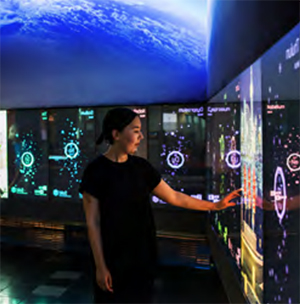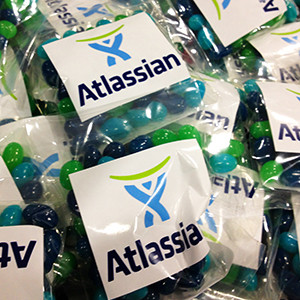FOR THE LAST FOUR YEARS, I’ve stretched my editing legs into technical writing, user guide creation, and process development and documentation for world-class Dev teams. As Communications Consultant for Cambridge software developers, Third Light; as a Change Analyst for Commonwealth Bank of Australia; as freelance writer for fintech strategy and commercial consultants, Whitecap Consulting; and as a writer on entrepreneurism for Forbes magazine — I’m getting my innovation on.
CAPITAL INVESTMENT CUBED: Queensland University of Technology
 On the rooftop patio of QUT’s Science and Engineering Centre, overlooking Brisbane’s Botanical Gardens, locals sip chardonnay and discuss the week’s Grand Challenge Public Lecture under the shade of arching solar panel ‘trees’ that power the building.
On the rooftop patio of QUT’s Science and Engineering Centre, overlooking Brisbane’s Botanical Gardens, locals sip chardonnay and discuss the week’s Grand Challenge Public Lecture under the shade of arching solar panel ‘trees’ that power the building.
A floor below, education undergraduates prepare for the next FIRST® LEGO® League challenge, which will hand awards to a creative selection of 500 Queensland school students for ‘perseverance’ and ‘gracious professionalism,’ as well as for strategy and mechanical design in programming robots to solve real world problems.
In the labs down the hall, academics tinker with mass spectrometers and analyse trace elements in fruit flies to better understand crop sustainability; while on the ground, central floor, families on Brisbane city walking tours marvel at two-storey-tall motion-responsive dinosaurs on the building’s interactive digital Cube—a massive, programmable touchscreen—before stepping down into the basement for a superfruit smoothie and a swim.
“The philosophy behind this place—the building and the institute that was designed around it—is easy for people to understand,” says Professor Ian Mackinnon, former executive director of the Institute for Future Environments. “We explore three environments: the natural, the built and the virtual. And where are all the problems—and solutions—of the next 30 to 50 years going to come from? From the interface of these three spaces.”
ARE YOU ANALYSIS READY? The processing and packaging of satellite data
 Collecting, calibrating, and curating decades’ worth of internationally acquired satellite data is no small task. Digital Earth Australia (DEA) provides almost 1.5 petabytes of free satellite imagery to Australians; and ensuring the data is ready for their use is a significant part of our work.
Collecting, calibrating, and curating decades’ worth of internationally acquired satellite data is no small task. Digital Earth Australia (DEA) provides almost 1.5 petabytes of free satellite imagery to Australians; and ensuring the data is ready for their use is a significant part of our work.
The hundreds of thousands of satellite images provided to us by the joint NASA/United States Geological Survey (USGS) Landsat program and European Union (EU) Sentinel program must be prepared for use in Australian contexts and quality-assured for application to Australian projects.
The data processing we undertake means we provide ‘analysis ready data’ (ARD) — allowing users to get up and running with their own analysis of the data as quickly as possible. This makes it simpler to develop applications with the data, and for databases to execute queries with minimal preparation.
Preparing analysis ready data means:
- Comparing and correcting imagery acquired at different times, seasons and geographic locations
- The orthorectification of images: removing the effects of image perspective (tilt) and relief (terrain) effects
- Adjusting imagery to correct for inconsistencies caused by a change in conditions each time an image is captured. These include water vapour, cloud cover, sun position, sensor view angle, surface slope and surface aspect
- Automating satellite data processing workflows based on Earth observation science and physical processes for testing and quality assurance
- Ensuring best practice data management, metadata standards, and common terminology. As a program of Geoscience Australia, we maintain the highest levels of international data standards.
WHEN I GROW UP: I want to be like Atlassian
 The whole ‘Atlassian’ thing is so cool, it should be easy to hate.
The whole ‘Atlassian’ thing is so cool, it should be easy to hate.
Over 12 little years, the software company has grown from a Sydney shed start-up (before start-ups were even starting up) into a $3.5 billion international venture admired by techs and entrepreneurs the world over – not only for its products, but also for its zero-sales-staff, “simplicity is core” model.
Its founding team of two (Mike Cannon-Brookes and Scott Farquhar – graduates who refused to swap jeans for suits) has evolved into a family of more than 900 people so frequently celebrating ‘Best Places To Work’ awards that they self-identify as ‘Atlassians’ rather than as employees.
With beer on tap, jelly beans on bean bags, board meetings over board games, in-office yoga and dogs in the office, Atlassians float between Sydney, San Francisco, and Amsterdam generally being brilliant and brainstorming the future of the world as we know it (“From medicine and space travel to disaster response robots, our products help teams all over the planet advance humanity through the power of software”) – while playing pool.
Make no mistake, these are the very clever, very cool kids.
The kicker is, they’re so damn nice.
When Cannon-Brookes and Farquhar launched Atlassian, it was with The Atlassian Foundation attached. Espousing the original One Per Cent Model; one per cent of Atlassian profits, one per cent of equity, one per cent of software licenses, and one per cent of employee time is donated to nonprofits. And this charitable engine has ticked over as Atlassian’s JIRA and Confluence products have wiggled their way into the bedrock of digital business through smart starter licenses.
12 years on, an estimated $3.5 billion company share valuation injects more than beer and skittles into the Foundation. Add to a corpus of approximately $35 million the $7 million already working in global grants, and the Atlassian Foundation – a private ancillary fund – is sitting on a tidy $40 million to distribute at 5 per cent, or approximately $2 million, every year. And dripping with the ‘Be the change you seek’ values that make Atlassian so successful, the Foundation is a source of company-wide pride.
THE UNCANNY ADVISER: At the CommBank Innovation Lab
 Today I had a mind-blowing experience as a volunteer tester for the Commonwealth Bank’s Social Robotics team: 30 minutes in the CBA Innovation Lab, testing human-robotic interaction.
Today I had a mind-blowing experience as a volunteer tester for the Commonwealth Bank’s Social Robotics team: 30 minutes in the CBA Innovation Lab, testing human-robotic interaction.
I was delighted to work with Chip, CBA’s humanoid robot and the only one of its kind in the Southern Hemisphere.
“This project is a watershed moment for robotics research in Australia and globally,” Mary-Anne Williams, Professor and Director of the Innovation and Enterprise Research Laboratory (The Magic Lab) at UTS syas of Chip’s work in the Lab.
“While there are research challenges and risks associated with the broader field of robotics, there are also extraordinary benefits for companies seeking to establish and maintain a leadership position in the disruptive field of social robotics.”
Hands-down, interacting with Chip was the most stimulating experience of my week, and I’m going to do whatever I can to spend more time in/around/near the Lab and its brilliant people.
What: In collaboration with UTS, the CBA Social Robotics team is developing a prototype AI ‘recommendation engine’.
Why: The project is an important part of the bank’s research into AI, how people interact with it, and the role that it could play in the lives of customers. Preliminary results will be presented at the leading Human-Robot Interaction conference in the US and inform which social robotics experiments are conducted at CBA over the course of this year. A-mazing.
TEN TOP FEATURES for better media management
The Third Light digital media library is a powerful web-based application for the professional management of image, video, audio, text, and other files. It’s packed with a suite of smart features for small businesses, education and research institutions, and blue-chip brands to better handle their digital content.
Media management tools: We’re proud to talk about the features that make our software stand out, but they’re also good standards against which anyone can measure the performance potential of a media library. Here, ten tools that you shouldn’t go without if better media management is your bread and butter:
1. Easy-to-use interface
The impact of an intuitive, navigable, visual user interface in a media management library is experienced in seconds, but replicated for years. Test your software before you buy: it should quickly feel like home.
2. Simple upload capabilities
The ingesting of all your media files into your library is only the beginning of your media management journey. Look for PC and Mac-friendly upload tools that let you drag-and-drop, upload in batches, and upload from phones and mobile-devices.
CASE STUDY: Third Light Client, UKTV
Satisfying 42 million viewers: UKTV is a multi-award winning media company with eleven core brands: UKTV Play, Dave, Watch, Gold, Alibi, Yesterday, Drama, Really, Home, Eden, and Good Food. It’s home to the most popular non-PSB channel in the UK, and reaches more than 42 million viewers every month. A ‘David to the Goliath brands’, UKTV is the fastest growing broadcaster in Britain.
“In 2012 we embarked on a large project to redevelop all of our consumer and business websites from the ground up,” says UKTV Head of Digital Delivery, Oliver Davies. “Moving from Cold Fusion, new channel sites were built in a fully responsive mobile-friendly grid, using a Python Django-based content management system. Our digital asset platform had to be the right fit.
“We’d never used a third-party digital asset management tool before, so we did lots of research into different systems, and made the decision to use Third Light as our tool for all our websites and digital products. It was a great fit for us. It simplified the storage, retrieval, and creation process of our images. We now had a single destination for all of our press imagery, which meant that other teams could use the library and enjoy the benefits too.
“The Third Light system was the right ‘size’ in terms of price and complexity, and it has all the features we need. It offers good value for money, and means that we can forget about image management (in the nicest possible way). We’ve been using it for a couple of years now and are very pleased with its performance.”
THE CREDIT 2.0 ECONOMY — A new borrowing landscape
 The Consumer Finance Association (CFA)’s report, ‘Credit 2.0 – a commentary on spending and borrowing in the 21st Century’ was published this summer to mixed reviews.
The Consumer Finance Association (CFA)’s report, ‘Credit 2.0 – a commentary on spending and borrowing in the 21st Century’ was published this summer to mixed reviews.
Critics claimed the report inflated the risks facing UK families as a result of the 2014 caps and regulations on short-term lending. Proponents celebrated the paper as an up-to-date snapshot of the personal loans industry.
The report’s findings were worthy of note for independent reasons. A reflection on hundreds of thousands of loan applications made to CFA members in 2015, the Credit 2.0 paper confirmed an increasingly apparent reality of the consumer finance industry: as the credit crunch hangover lifts, the UK economy is awakening to a dramatically changed — and changing — environment.
“The economy is growing again,” said CFA Chief Executive, Russell Hamblin-Boone, addressing members of parliament at the launch of the report, “but the financial landscape has changed forever. Technology is changing the way we live, and our ‘instant society’ demands quick decisions, simple products, and convenient ways to borrow small sums for short periods of time.
“Critics of innovation that refuse to embrace the change by trying to hold back the tide, could find themselves swept away by modern life.”



